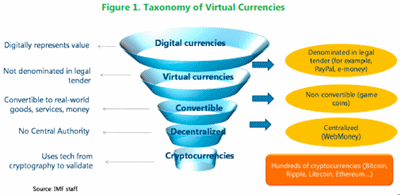The IMF's Lagarde holds up a print copy of 'Virtual Currencies and Beyond : Initial Considerations'.
Using the link given in that same post, I downloaded a copy of the document, loaded it onto my Kindle, and spent an hour studying its content. Here is a useful graphic (p.8) explaining the term 'Virtual Currencies'.

The orange 'Cryptocurrencies' box in the lower right says,
Hundreds of cryptocurrencies (Bitcoin, Ripple, Litecoin, Ethereum, ...)
And here is an outline of the table of contents.
5 EXECUTIVE SUMMARY
6 INTRODUCTION
6 A. Overview
7 B. What are Virtual Currencies?
10 ARE VIRTUAL CURRENCIES MONEY?
11 A. Perspectives from Theory and History
16 B. Legal Perspectives
17 C. Economic Perspectives
18 DISTRIBUTED LEDGERS
18 A. What Are They and How Do They Work?
21 B. Emerging Uses of Distributed Ledgers
24 REGULATORY AND POLICY CHALLENGES
24 A. Regulatory Challenges and Responses
27 B. Financial Integrity: AML/CFT
28 C. Consumer Protection
30 D. Taxation
31 E. Exchange Controls and Capital Flow Management
31 F. Financial Stability
33 G. Monetary Policy
35 THE WAY FORWARD
38 SELECTED BIBLIOGRAPHY
Better than the 'EXECUTIVE SUMMARY' (p.5) is the 'INTRODUCTION' (p.6). Here are the bullets minus their explanations.
INTRODUCTION • A. Overview
1. New technologies are driving transformational changes in the global economy, including in how goods, services, and assets are exchanged.
2. An important development in this process of transformation has been the emergence of virtual currencies (VCs).
3. VCs and their underlying distributed ledger technologies have the potential to generate benefits.
4. However, these technologies also pose risks.
5. Any policy response to VCs will need to strike an appropriate balance between forcefully addressing risks and abuses while avoiding overregulation that could stifle innovation.
6. This paper discusses the potential benefits and risks posed by VCs and how financial regulators could approach them.
7. As a starting point, it is important to note that the VC landscape is still new and rapidly changing.
I know the document wouldn't go over well with the 'let's-have-anarchy' crowd, but I found it useful for understanding the current issues facing bitcoin++.